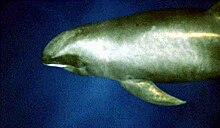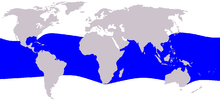Melon-headed whale: Difference between revisions
Luckas-bot (talk | contribs) m r2.7.1) (Robot: Adding pnb:دوانہ سر وہیل |
|||
| Line 38: | Line 38: | ||
==Conservation== |
==Conservation== |
||
The melon-headed whale is included in the Memorandum of Understanding Concerning the Conservation of the Manatee and Small Cetaceans of Western Africa and Macaronesia ([ |
The melon-headed whale is included in the Memorandum of Understanding Concerning the Conservation of the Manatee and Small Cetaceans of Western Africa and Macaronesia ([[West African Aquatic Mammals Memorandum of Understanding|Western African Aquatic Mammals MoU]]) and the Memorandum of Understanding for the Conservation of Cetaceans and Their Habitats in the Pacific Islands Region ([[Pacific Islands Cetaceans Memorandum of Understanding|Pacific Cetaceans MoU]]) |
||
==References==<!-- Micronesica38:239. --> |
==References==<!-- Micronesica38:239. --> |
||
Revision as of 16:34, 20 September 2012
| Melon-headed whale | |
|---|---|

| |

| |
| Size compared to an average human | |
| Scientific classification | |
| Missing taxonomy template (fix): | Peponocephala electra |
| Binomial name | |
| Peponocephala electra (Gray, 1846)
| |

| |
| Melon-headed whale range | |
The melon-headed whale (species Peponocephala electra; other names are many-toothed blackfish and electra dolphin) is a cetacean of the oceanic dolphin family (Delphinidae). It is closely related to the pygmy killer whale and pilot whale, and collectively these dolphin species are known by the common name blackfish. It is also related to the false killer whale.[1] The melon-headed whale is widespread throughout the world's tropical waters, although not often seen by humans because it prefers deep water.[2]
Description
The Melon-head has a body shape rather like a torpedo. Its head is a rounded cone giving the animal its common name. The body is more or less uniformly light grey except for a dark grey face – sometimes called the "mask". The flippers are long and pointed. The dorsal fin is tall with a pointed tip – reminiscent of its cousin the Orca. When viewed in profile its head is not as rounded as the Pygmy Killer and this may aid identification.
This whale is capable of very fast swimming, particularly when startled. In flight, it often makes short low jumps clear of the sea surface, splashing lots water. Melon-heads usually gather in large numbers (at least 100 and possibly as many as 1,000 on rare occasions) and sometimes strand together.
The Melon-head weighs 10–15 kilograms (22–33 lb) at birth and is 1 metre (3.3 ft) long. An adult grows up to 3 metres (9.8 ft) long and weighs over 200 kilograms (440 lb). The whales' lifespan is at least 20 years and probably more than 30 years for females.
Their primary diet is squid.
Hawaiian melon-heads spend much of their daytime at the surface resting.[1]
Population and distribution
The melon-headed whale lives far from shore in all the world's tropical and sub-tropical oceans. At the northern fringes of its range it may also be found in temperate waters. Individuals have been sighted off the southern coast of Ireland. Ordinarily, however, the Melon-head is found beyond the continental shelf between 20° S and 20° N. Hawaii and Cebu, in the Philippines, are good sites for seeing the whale because the continental shelf there is narrow. Although no specific data exists, the species is unlikely to be migratory, in common with animals in its subfamily.
On February 10,2009, over 300 melon-headed whales were spotted off the shallow waters of Bataan, in the Philippines.[3] Local residents and volunteers guided the dolphins back to deeper waters. Although no definite explanation has been provided for the dolphins' behaviour, it's been noted that two of the three dead dolphins had damaged ear drums.[4]
In Hawaii, group sizes are variable, ranging from a single animal to pods of 800, but typically they are found in relatively large groups (median = 287 individuals).There appear to be two Hawaiian populations a large, deep water group that moves frequently among the islands and a small, shallow water population that stays near the island of Hawaiʻi. Melon-headed whales are closely related to false killer whales, short-finned pilot whales and pygmy killer whales. Hawaiian melon-heads spend much of their daytime at the surface resting.[1]
Conservation
The melon-headed whale is included in the Memorandum of Understanding Concerning the Conservation of the Manatee and Small Cetaceans of Western Africa and Macaronesia (Western African Aquatic Mammals MoU) and the Memorandum of Understanding for the Conservation of Cetaceans and Their Habitats in the Pacific Islands Region (Pacific Cetaceans MoU)
References
- Template:IUCN2008 Database entry includes justification for why this species is of least concern
- National Audubon Society: Guide to Marine Mammals of the World ISBN 0-375-41141-0
- Encyclopedia of Marine Mammals ISBN 0-12-551340-2
Notes
- ^ a b c "Melon-headed whales in Hawai'i". Cascadia Research Institute. September, 2010. Retrieved October,2010.
{{cite web}}: Check date values in:|accessdate=and|date=(help) - ^ Froese, Rainer; Pauly, Daniel (eds.) (2006). "Peponocephala electra" in FishBase. April 2006 version.
- ^ Hundreds of Dolphins Sighted in Bataan-waters
- ^ Melon-head stranding
External links
- BBC: Hundreds of whales rescued in Philippines
- Aschettino, J.M. 2010. Population size and structure of melon-headed whales (Peponocephala electra) around the main Hawaiian Islands: evidence of multiple populations based on photographic data. M.Sc. Thesis, Hawai‘i Pacific University. 117 pp.
- Baird, R.W., J.M. Aschettino, D.J. McSweeney, D.L. Webster, G.S. Schorr, S. Baumann-Pickering and S.D. Mahaffy. 2010. Melon-headed whales in the Hawaiian archipelago: an assessment of population structure and long-term site fidelity based on photo-identification.
- Southall, B.L., R. Braun, F.M.D. Gulland, A.D. Heard, R.W. Baird, S.M. Wilkin, and T.K. Rowles. 2006. Hawaiian melon-headed whale (Peponocephala electra) mass stranding event of July 3–4, 2004. NOAA Technical Memorandum NMFS-OPR-31.
- Memorandum of Understanding Concerning the Conservation of the Manatee and Small Cetaceans of Western Africa and Macaronesia.
- Official webpage of the Memorandum of Understanding for the Conservation of Cetaceans and Their Habitats in the Pacific Islands Region

